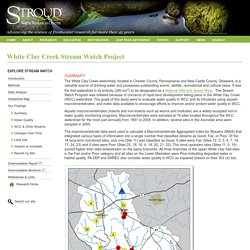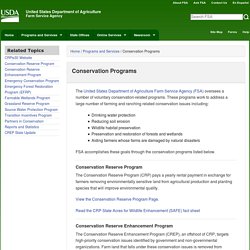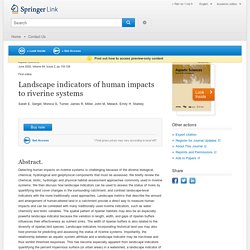

Dcnr 002154. SMART Conservation Software. Stroud Water Research Center: Stream Watch. The White Clay Creek watershed, located in Chester County, Pennsylvania and New Castle County, Delaware, is a valuable source of drinking water and possesses outstanding scenic, wildlife, recreational and cultural value.

It was the first watershed in its entirety (280 km2) to be designated as a National Wild and Scenic River. The Stream Watch Program was initiated because of concerns of rapid land development taking place in the White Clay Creek (WCC) watershed. The goals of this study were to evaluate water quality in WCC and its tributaries using aquatic macroinvertebrates, and make data available to encourage efforts to improve and/or protect water quality in WCC. Aquatic macroinvertebrates (insects and non-insects such as worms and mollusks) are a widely accepted tool in water quality monitoring programs. Macroinvertebrates were sampled at 18 sites located throughout the WCC watershed for the most part annually from 1991 to 2008. Download the Stream Watch report. Solutions - WCS.org. Conservation Programs. The United States Department of Agriculture Farm Service Agency (FSA) oversees a number of voluntary conservation-related programs.

These programs work to address a large number of farming and ranching related conservation issues including: Drinking water protectionReducing soil erosionWildlife habitat preservationPreservation and restoration of forests and wetlandsAiding farmers whose farms are damaged by natural disasters FSA accomplishes these goals through the conservation programs listed below. The Conservation Reserve Program (CRP) pays a yearly rental payment in exchange for farmers removing environmentally sensitive land from agricultural production and planting species that will improve environmental quality. View the Conservation Reserve Program Page.
Read the CRP State Acres for Wildlife Enhancement (SAFE) fact sheet View the Conservation Reserve Enhancement Program page. View the Emergency Conservation Program page. View the Emergency Forest Restoration Program page. Please Login for this Restricted Resource. Please Login for this Restricted Resource. Landscape indicators of human impacts to riverine systems. Detecting human impacts on riverine systems is challenging because of the diverse biological, chemical, hydrological and geophysical components that must be assessed.

We briefly review the chemical, biotic, hydrologic and physical habitat assessment approaches commonly used in riverine systems. We then discuss how landscape indicators can be used to assess the status of rivers by quantifying land cover changes in the surrounding catchment, and contrast landscape-level indicators with the more traditionally used approaches. Landscape metrics that describe the amount and arrangement of human-altered land in a catchment provide a direct way to measure human impacts and can be correlated with many traditionally used riverine indicators, such as water chemistry and biotic variables. Key words. Landscape metrics; indicators; human impacts; river. Please Login for this Restricted Resource. Annual%20Report. NorthwestAdamsJointCompPlan03 2010sm. USDA Forest Service - Forest Legacy Program. Join the NRCS Team. At the U.S.

Department of Agriculture’s Natural Resources Conservation Service (NRCS) we need people who are committed to action. People who want to apply their education and experience to make sure that all of us enjoy the benefits of productive soil, clean water, clean air, and abundant wildlife that come from a healthy environment. NRCS offers career opportunities in Natural Resources and Conservation. To explore our application process or learn about special programs available to applicants, visit our Applicant Resource Center. Our Conservation Careers include Soil Conservationists and Soil Conservation Technicians, Engineers, Soil Scientists, Rangeland Management Specialists, Biologists, and many more. The Silver Lining - 25 Years of the Conservation Reserve Program.
iConservePA. Home/land owners Our homes are our castles, no matter if they are tiny apartments or actual castles.
We can all take steps inside our homes or in our yards (if we have them), to save resources. Try on some of these ideas. Inside your home. Big changes, little changes all make a difference in the amount of energy and water you consume and waste you produce. Around the yard. Find more help through these topics: • Common Trees • Tree Pests and diseases • Storm water • Rain gardens • Composting • Sinkholes, landslides, earthquakes • Private water wells • If you make more choices to buy food that’s grown nearby your home, or if you choose to recreate in parks and forests just a short drive away, you are supporting local economies and cutting back on emissions.
. • Everyone likes to save a little cash. . • Some are lucky to own a piece of Penn’s Woods. Birding Adams County. Short-eared Owl perched in the snow by Jacob Dingel, PGC We are very glad to have the Pennsylvania Society for Ornithology (PSO) as a partner in Pennsylvania eBird.

As part of our goal to educate birders about great places to find birds in the state and encourage data submission for more locations, we are teaming with PSO to present some locations that deserve more birders. Freedom Township grasslands. Latham%20Thorne%20Keystone%20grasslands. AdamsCountyGreenwaysPlan web. Grassland IBA.